10 Awesome Knowledge Base Examples of 2025
The ease with which customers can understand the brand leads to its success. And in today’s blog, we are going to let you know about some of the best knowledge base examples you can choose from. Before moving further, let us consider a scenario. Imagine that you purchase a new gadget with high functionalities. But, it does not contain an instruction manual. You will surely be disappointed with such a user-experience. A similar scenario will occur in case of the absence of a knowledge base on an online platform. It acts as a user manual and central resource for the business.
A fully-functional knowledge base contains extensive information for solving user-problems. This even plays a key role in reducing human support, unlike earlier days, when people kept documents or even in ancient days of manuscripts. Nowadays, all of the information is designated in knowledge management software.
But what is its need? What benefits does a knowledge base system serve? What are its examples?
To answer all these questions, let us walk you through it.
Benefits of a knowledge management system
Whether it be a small business or a large business, the knowledge base is equally important for all. When a customer contacts your brand, they expect it to be organized with a streamlined process. An efficient knowledge base system sorts that for you. Here are its benefits.
1. Provision of self-service for customers:
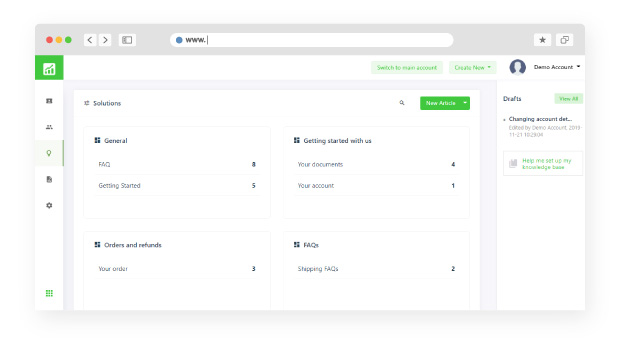
To resolve simple issues, customers prefer finding solutions on their own. Only in extreme conditions, they would want to make a call. A knowledge base in hand can save ample time and effort on customers’ behalf. They surely don’t want to spend time waiting for customer care contact.
2. Round the clock accessibility:
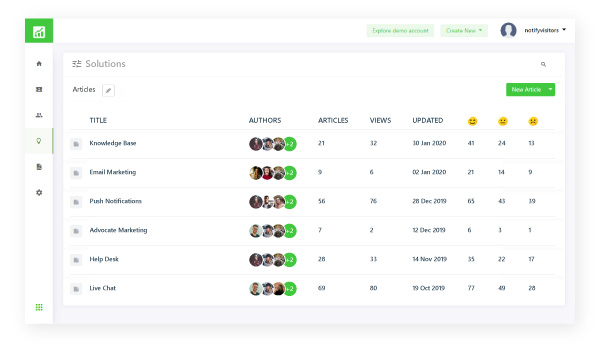
It might not be feasible to have a customer support team available on call 24*7. However, a knowledge base resolves this issue. It is the go-to place for customers to increase satisfaction. This helps in delivering a good brand image and positive experience.
3. Reduction in workload:

A knowledge base system resolves simple issues. This allows the customer support team to focus on and fix the complex issues. This leads to a massive workload reduction and streamlining workflow.
4. Increase in organic visits:
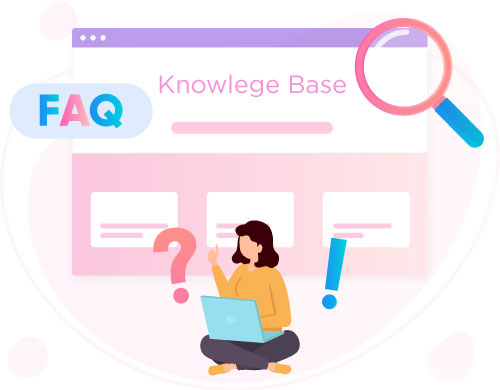
The various elements like videos, images, articles, FAQs, lead to higher user engagement. This can bring you some organic traffic on your platform. Further, it can also help in increasing your Google rank.
5. Lower costs and investments:

Once you have a well-managed knowledge management system, your team can divert attention to other tasks. This provides a better work environment with improved functionality. This also reduces the expenditure on hiring employees and their training.
6. Immersive and in-depth knowledge:
There are instances when customers want to dive deeper into their topics of interest. The optimized knowledge base helps them with it. This leads to a positive customer experience.
Tips for knowledge base system optimization
Once you have a knowledge base, it is only half the battle won. The next quintessential step is to keep it updated and actively managed. To have an impact, make sure you serve the best content to your customers. Here are some of the tips to follow.
a) Easy to grasp content:
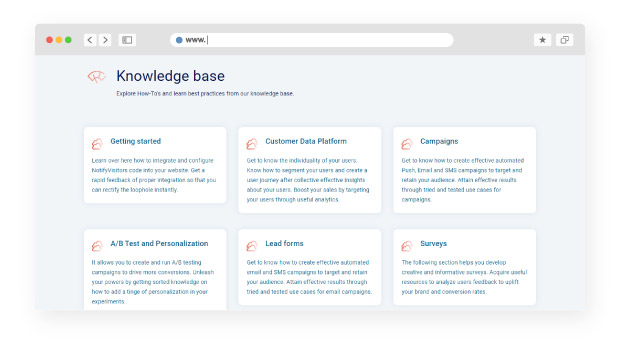
Don’t stuff your content with jargon. Make it easy to understand. When people have any queries, they look for answers and no complexities. They wouldn’t want to search for the meaning of your content. This will be tiresome for them.
b) Use the analysis for well-informed decisions:
In case you have already set up the knowledge base, keep an eye on the analytics. This will help you understand the CTR and the rebound rate. Understand the key areas of improvement. Improve the structure and content accordingly. With analytics in hand, you can make better decisions for improvement.
c) Have the ultimate goal:

All the efforts boil down to the point of optimum user experience. While preparing the knowledge base system, be clear that it provides sufficient information to customers. Ensure that once the customers visit the page, they will be satisfied and won’t have to search further. Place yourself in the customer’s shoes. If you are satisfied, then give it a go. However, in case you are not, then implement the changes before finally putting it out.
d) Take regular feedback:
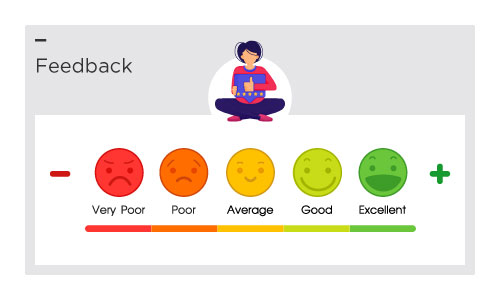
Honest customer feedback is no less than a treasure. Check with customers regularly. Know their expectations and build the knowledge base system around that. You can do this through a survey, a set of questions, and other such strategies.
e) Easy navigation:
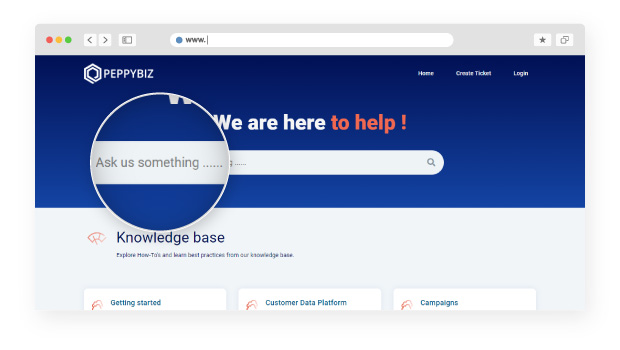
You don’t want your customers to get lost and end up being unsatisfied. Please provide them with a clear path for every query. This helps them land on a conclusion and get what they expect. In case customers aren’t unable to find their solutions, provide them with a contact they can reach out to instantaneously.
Let’s start discussing some of the best knowledge base examples.
Best Knowledge Base Examples
Many online platforms are adopting the knowledge base strategy. So, if you plan to implement it in your business, you can take inspiration from them. However, keep your ideas and content unique. Here are some of the best knowledge base examples you can count on.
1. PeppyBiz:
We are an IT solutions company and help your business get ahead of others. The PeppyBiz knowledge base provides you with several features for a proactive self-service approach. These features include:
- Easy creation of articles and editing with the powerful visual editor
- Management of knowledge completely with a well-structured hierarchy
- Power search option for quickly getting the content you are looking for
- Understanding customer needs and optimizing content accordingly
- SEO optimized content to rank up on the Google page
- Multilingual content to help users and reach a wider audience
- Chat option for easily sharing of articles and building a community
- Customization of all details of the knowledge base
2. Canva:
For all the artsy users, Canva is popularly becoming their go-to option. It is a graphic design platform that provides marketers with an online space for several print materials. Right from banners to social media platforms, you can create all graphic content easily. Canva lays out its knowledge base in a very effective format. It interconnects various topics by directing people to answers they require quickly. They help the users to delve from simpler topics to complex ones. Further, their way of presenting and curating information is exceptional.
3. Hubspot Academy:
Hubspot is quite a big name in the inbound marketing world. It has cultivated several resources that provide users with ample information across marketing and enterprise platforms. They ensure that they are present at every step of the buyer’s journey. They provide the knowledge base in the form of Hubspot Academy. Here, they provide in-depth knowledge at several levels.
4. Asana:
It is a project management software that manages all its complex workflows well. It acts as a potent tool for customer onboarding. They have a clutter-free design, which allows them to focus on the topics. Further, they divide all the knowledge into sequential topics, which allows the users to teach themselves.
5. MailChimp:
They work efficiently for carrying out email marketing campaigns. With this, the hosts can easily streamline their marketing process. With a search bar, they make the navigation simpler. This allows the customers to dig deeper into their massive knowledge base. They deliver all the information in a clear and concise format.
Additionally, they have a provision of highlighted notes, which makes the searching process easier and faster. One thing you can take from them is to provide users with a summary of all the information you provide. Further, you can break up and divide the information.
6. Fitbit:
They provide smart bands for a healthy lifestyle. They provide a knowledge base through a community forum. This allows the customers to have a good conversation and discussion over their products. Alongside this, they also ensure that their customers get the correct information and regular updates.
7. Dropbox:
They allow the customers to resolve the majority of their issues directly on the main page itself. Their featured articles play a major role in customer help cases. They deepen customer engagement by leaps and bounds.
8. Dyson:
This company provides a wide range of home appliances and has an enormous customer base. For specially designed products, they use their pictures. This helps the customers reach the right section quickly and get the required information.
9. CampaignMonitor:
They provide the users with a well-structured article set. They break down the content into several areas depending on their functionality. This allows the customers to reach the right area without bothering much.
10. Wix:
They provide an uncluttered knowledge base. They provide users with a center stage search option. This enables them to gain answers without much delay quickly. With the search function, they can also get automatic suggestions depending on their areas of interest.
Are you planning to incorporate knowledge management software for your company? Then, you can choose easily from ample options available online for seamless operations.
Conclusion:
With all said and done, knowledge management software is integral for every business. It helps in providing information about every aspect of your business. This further leads to high customer satisfaction and retention. So, without any delays, get the knowledge management software set up for your business right away. After all, a happy customer is the biggest treasure.
Let us know your opinion about this post on Knowledge base Examples by commenting down below



